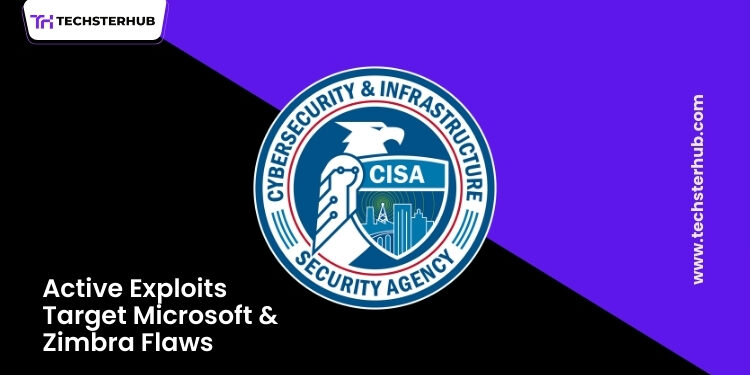CISA has updated its Known Exploited Vulnerabilities (KEV) catalog with two critical vulnerabilities which require immediate action from organizations to prevent exploitation. Cybercriminals have been actively exploiting vulnerabilities present in Microsoft products and Zimbra which requires immediate patching by businesses and users to prevent potential attacks on their systems. The inclusion of these vulnerabilities in the KEV catalog serves as CISA’s warning that organizations should be aware of the growing danger these flaws present.
This article will examine the specific vulnerabilities and their risks while discussing the importance of CISA’s decision to add them to the KEV catalog for digital infrastructure protection.
What Is the KEV Catalog?
The Known Exploited Vulnerabilities catalog from CISA features a collection of security flaws which cybercriminals currently exploit. The catalog enables organizations to recognize and address high-risk security vulnerabilities within their systems. The KEV catalog remains current through collaboration between CISA, government agencies, cybersecurity researchers, and vendors to address critical vulnerabilities and prevent widespread attacks.
The KEV catalog serves as a component of CISA’s comprehensive strategy to improve national cybersecurity defences and safeguard vital infrastructure from harmful threats. When a vulnerability gets listed in the KEV catalog organizations need to take immediate action to address the threat by applying patches or using other security strategies.
The Microsoft Vulnerability in the KEV Catalog
The recent update to the KEV catalog includes a new vulnerability that affects Microsoft Exchange Server which serves as both an email and calendar platform. The Microsoft Exchange service contains a privilege escalation flaw identified as CVE-2023-23397 which attackers exploit by sending specially crafted emails. When attackers exploit this vulnerability, they are able to access the system with equivalent privileges to the email recipient.
Why This Vulnerability Is Dangerous:
- Active Exploitation: Because cybercriminals are actively exploiting this vulnerability organizations operating Microsoft Exchange servers should prioritize immediate patch application.
- Remote Code Execution: This software vulnerability enables attackers to execute arbitrary code remotely on targeted systems without requiring user interaction. The vulnerability can result in attackers taking total control of the server.
- Wide Attack Surface: The use of Microsoft Exchange across various organizations from small businesses to large enterprises means this vulnerability affects numerous systems on a wide scale. Attackers gain access to corporate networks through this vulnerability which enables them to conduct additional harmful activities including data theft, ransomware deployment and network lateral movement.
Steps to Mitigate the Risk:
- Patch Immediately: Microsoft has developed security patches to resolve CVE-2023-23397. To minimize the possibility of exploitation organizations must apply these patches immediately.
- Use Secure Email Practices: Implement anti-phishing and anti-malware filters to lower the chances of obtaining harmful emails which could activate this security flaw.
- Monitor Exchange Logs: Administrators need to perform routine checks on Microsoft Exchange logs to identify any abnormal actions including unauthorized logins and signs of system exploitation.
The Zimbra Vulnerability in the KEV Catalog
Zimbra which is an open-source email collaboration platform was added as the second vulnerability entry to the KEV catalog. CVE-2023-29054 targets Zimbra Collaboration Suite (ZCS), enabling attackers to execute unauthorized commands remotely on affected systems.
Why This Vulnerability Is Dangerous:
- Remote Command Execution (RCE): The vulnerability enables attackers to execute commands from remote locations on the Zimbra server and achieve complete system control. Organizations that depend on Zimbra for their email and collaboration needs face severe consequences from this vulnerability.
- No Authentication Needed: Attackers can exploit this vulnerability without needing to authenticate themselves to the system. The lack of a requirement for prior access to systems enables cybercriminals to execute attacks more efficiently.
- Widespread Impact: Numerous educational institutions along with government agencies and businesses across the globe utilize Zimbra for their email and collaboration needs. Untreated vulnerabilities may result in major data breaches and service disruptions.
Steps to Mitigate the Risk:
- Apply Security Patches: Zimbra has released patches to address CVE-2023-29054. Zimbra users need to promptly update their systems to stay safe.
- Monitor for Unusual Activity: Zimbra administrators must regularly check server logs and system operations to detect any exploitation attempts or unauthorized command activities.
- Limit External Access: Organizations should prevent external connections to their Zimbra servers and deploy network segmentation strategies to stop attackers from accessing vulnerable systems.
What Does CISA’s Inclusion of These Vulnerabilities in the KEV Catalog Mean?
By including these vulnerabilities in the KEV catalog CISA demonstrates their serious threat level to organizations worldwide. Organizations remain at major risk from live attacks because cybercriminals actively exploit these vulnerabilities.
Importance of Timely Action:
- Heightened Risk: The inclusion of a vulnerability in the KEV catalog indicates that attackers are currently exploiting that flaw. Organizations risk data breaches and operational disruptions if they neglect to apply patches to these vulnerabilities swiftly.
- Mandatory Action for Federal Agencies: The binding directive BOD 22-01 mandates that CISA requires federal agencies to address vulnerabilities listed in the KEV catalog by following a set timeline. The requirement targets federal agencies but CISA advises private sector organizations to promptly address these vulnerabilities.
- Increased Cybersecurity Awareness: CISA enhances understanding of these vulnerabilities by listing them in the catalog. Organizations need to examine their systems and implement necessary updates to protect against known and currently exploited weaknesses.
The Role of CISA in National Cybersecurity
CISA ensures U.S. cybersecurity through various resources and alerts which help organizations defend their systems against cyber threats. The KEV catalog provides organizations with a vital mechanism to rank security patches according to the highest priority risks.
By incorporating Microsoft and Zimbra vulnerabilities into the catalog CISA demonstrates both the expansion of cyber threats and the necessity for ongoing security awareness. CISA’s catalog enables organizations to maintain their security by offering a complete list of critical flaws which cybercriminals target to compromise widely used software.
Conclusion
CISA’s addition of Microsoft Exchange Server’s CVE-2023-23397 and Zimbra’s CVE-2023-29054 to the KEV catalog underscores the critical need for organizations to remedy actively exploited security vulnerabilities. Without timely patches these vulnerabilities could cause serious issues including data breaches system compromises as well as operational disruptions. Businesses must promptly implement security patches and keep track of unusual system activities while adopting top security procedures to protect their infrastructure.
CISA’s initiatives emphasize the necessity for strong cybersecurity protocols while highlighting the critical importance of keeping current with emerging security threats. Businesses and government agencies that focus on fixing known exploited vulnerabilities will lower their chances of experiencing cyberattacks and protect their sensitive data from malicious threats.











